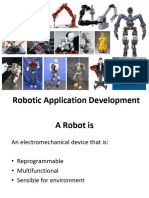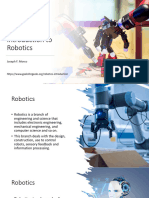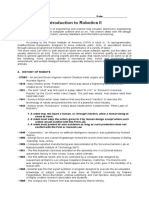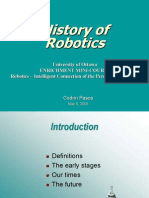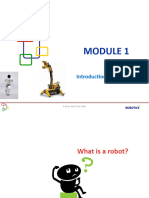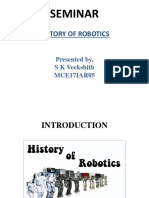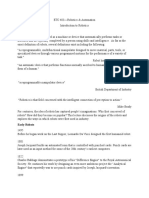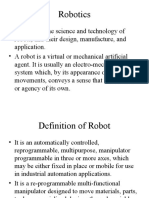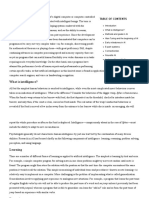Short History of Robotics
Pre-History of Real-World Robots:
One of the first robots was the clepsydra or water clock, which was made in 250 B.C. It was created by Ctesibius of Alexandria, a Greek physicist and inventor.
Hero from Alexandria built robot theater
�Jacques de Vaucanson (1709-1782)
Master toy maker who won the heart of Europe. Flair for inventing the mechanical revealed itself early in life. He was impressed by the uniform motion of the pendulum of the clock in his parents hall. Soon he was making his own clock movements.
�James Watt
�Mechanical horse
�Pre-History of Real-World Robots:
The earliest remote control vehicles were built by Nikola Tesla in the 1890's. Tesla is best known as the inventor of AC power, induction motors, Tesla coils, and other electrical devices.
�Robots of the media
�Popular culture influenced by these ideas
History of Robotics?
RUR Metropolis(1927) Forbidden planet(1956)
2001 A Space Odyssey(1968)
Logans Run(1976) Aliens(1986)
�Robot Continuum Robot continuum
...
1921
�Robot Continuum
Karl Capek
...
1921 2020
�Robot Continuum Robot continuum
Karl Capek
Dalek
...
1921 2020 2150
�Robot Continuum Robot continuum
Karl Capek
Dalek
...
1921 2020 2150 2421
�Robot Continuum Robot continuum
Let us step down fantasies.. Tortoise
...
1951
� Other early robots (1940's - 50's) were Grey Walters Elsie the Tortoise ("Machina speculatrix") and the Johns Hopkins "beast."
History of RealWorld Robots:
�Grey Walter's tortoise, restored recently by Owen Holland and fully operational
What are robots made of?
Sensors: Light Sensors
Grey Walters Tortoise
�Isaac Asimov and Joe Engleberger
Two fathers of robotics Engleberger built first robotic arms
�History of Real-World Robots:
The first modern industrial robots were probably the UNIMATES, created by George Devol and Joe Engelberger in the 1950's and 60's. Engleberger started the first robotics company, called "Unimation", and has been called the "father of robotics."
Unimates, late 50s to early 60s Automotive Industry Recent Recovery Worth over $500 million
99% are industrial
�The Advent of Industrial Robots -
Robot Arms
There is a lot of motivation to use robots to perform task which would otherwise be performed by humans:
Safety Efficiency Reliability Worker Redeployment Cheaper
�What are they?
Most of the industrial robots used in factories throughout the world exhibit few of the characteristics that the average person would associate with the term "robot" Many are simple "pick and place" machines Lets have a working definition for an industrial robot These machines are programmable, are automatic and can perform a wide variety of tasks
�Robot Manipulators
�Pick and Place Machines (robots?)
Simplest kind of industrial robot Still some on production lines but are being phased out Perform simple pickup and drop functions Cannot sense environment The limits of motion of each joint of the machine are fixed by electric or pneumatic impulse originating at a plug-board control panel
�Servo Robots
A more sophisticated level of control can be achieved by adding servomechanisms that can command the position of each joint. The measured positions are compared with commanded positions, and any differences are corrected by signals sent to the appropriate joint actuators. This can be quite complicated
�What are robots made of?
Effectors: Manipulation
Degrees of Freedom
�Degrees of Freedom
For the robot arms to become more flexible, more "degrees of freedom" or planes of free movement had to be added. Many industrial arms have 6 or more planes of motion
�Teach and Play-back Robots
Once the math is solved it is a relatively simple matter to teach a robot how to pick something up and what to do with it. Teaching involves moving the arm through the motions it is expected to perform During Recall mode the arm repeats, verbatim, what it has been taught
�Teach and Play-back Robots
�An Arm's Simple World
Life is simpler for a robot arm which can always expect objects to be oriented in the same way. It only has to worry about its own coordinate system. The math gets complex but is manageable
�The U.S. military contracted the "walking truck" to be built by the General Electric Company for the U.S. Army in 1969.
Walking robots
�History of Real-World Robots:
The walking truck was the first legged vehicle with a computer-brain, developed by Ralph Moser at General Electric Corp. in the 1960s.
It was a large (3,000 pounds) four legged robot that could walk up to four miles a hour.
�The Army and the Artificial Elephant
General Electric Walking Truck.
A human controlled the stepping of this robot by pushing pedals with his feet. The complicated coordination of movements within a leg and between different legs during stepping was controlled by a computer
�The Army and the Artificial Elephant
Project failed because of the "unanticipated computational difficulty" of simultaneously controlling all of the degrees of freedom in the four legs. This failure dramatically demonstrated the sophistication that control systems must have to produce successful walking behavior in legged mechanisms.
�Marvin Minsky
MIT Pioneer of AI and Robotics
Robotics and AI are very new research areas, most pioneers are alive and well.
�Over Confidence
Soon people had faith in their own ability to solve what turned out to be extremely complex control problems
�A Robot's More Complex World
It gets more complex when you expect an arm to pick up objects which can be in any orientation. There are several problems
How do you pick it up? How do you recognize it is there? How do you know you are holding it firmly? How do you have to change your grip to hold it the way you need to?
This is still a subject of much research
�Expanding Horizons
Undaunted by previous failures, robotocists continued research in the field People thought a good strategy would be:
to start from the state-of-the-art as practiced in industrial robotics and gradually expand the sensory and control capabilities until the more difficult tasks became tractable.
This was the strategy adopted by the robotics group at S.R.I
�History of Real-World Robots:
Shakey" was a small unstable box on wheels that used memory and logical reasoning to solve problems and navigate in its environment. It was developed by the Stanford Research Institute (SRI) in Palo Alto, California in the 1960s.
�Shakey Shakey of Nilsson
Nils Nilsson @ Stanford Research Inst.
first general-purpose mobile platform
...
1968
...
�Shakey the robot.
Shakey was the first mobile robot that could think independently and interact with its surroundings
Conceived as a demonstration project for the Advanced Research Projects Agency (ARPA) artificial Intelligence program
�Shakey (cont)
Shakey could be given a task such as finding a box of a given size, shape, and color and told to move it to a designated position. Shakey was able to search for the box in various rooms, cope with obstacles, and plan a suitable course of action. It was controlled by an off-board PDP-10 computer through a radio link. It carried :
a TV camera, an optical range finder, and touch sensors
so that it could know when it bumped into something.
�Shakey (cont)
While Shakey was a success in some respects it was a great failure as far as autonomy was concerned... It was controlled by an off-board computer It could only detect the baseboards of the special rooms it worked in It could not deal with an unconstrained environment It was really slow!
Shakey (cont)
�Shakey Shakey (cont)
Nils Nilsson @ Stanford Research Inst.
first general-purpose mobile platform
Living Room (L)
Kitchen (K)
sp
sh
tv tvg
Bedroom (B)
...
1968
...
�Shakey Start Shakey (cont)
START At(sh,L) At(sp,K) At(tvg,B) At(tv,L) ACTIONS
Go(x,y)
Preconditions: At(sh,x) Postconditions: At(sh,y)
Go(L,B) Go(L,K)
Push(tv,L,B) Push(tv,L,K) At(sh,K) At(sp,K) At(tvg,B) At(tv,K)
Push(obj,x,y) Preconditions: At(sh,x) At(obj,x) Postconditions: At(sh,y) At(obj,y)
At(sh,L) At(sp,L) At(tvg,L) At(tv,L)
GOAL
�Stanford Cart Stanford Cart
world modeling task execution
SENSING
motor control
perception
functional task decomposition
...
1976
planning
Hans Moravec @ SAIL
ACTING
...
�AI - Historical Perspective
Artificial Intelligence began with very ambitious goals in the 1950s & 60s Most initial work on AI focused on severely abstracted toy problems Recent work (mid-80s to present) has been very successful in finding applications that are firmly grounded in the real world
Intelligent assistants Computer vision for navigation, graphics Robotics systems for manufacturing Speech analysis & generation
Basic observations:
Artificial Intelligence has specialized into many inter-related but distinct disciplines Tasks performed effortlessly by humans & animals often are the hardest to emulate
�History of AI
1947~1959
cybernetics 1947 Dartmouth 1956
McCulloch and Pitts (1943)
Neural networks that learn
Minsky (1951)
Built a neural net computer
1960~1964
LISP(1960) GPS(1963)
Darmouth conference (1956):
McCarthy, Minsky, Newell, Simon met, Logic theorist (LT)- proves a theorem in Principia Mathematica-Russel. The name Artficial Intelligence was coined.
1952-1969
GPS- Newell and Simon Geometry theorem prover - Gelernter (1959) Samuel Checkers that learns (1952) McCarthy - Lisp (1958), Advice Taker, Robinsons resolution Microworlds: Integration, block-worlds. 1962- the perceptron convergence (Rosenblatt)
�History of AI, continued
1966-1974 a dose of reality
Problems with computation
1969-1979 Knowledge-based systems
Weak vs. strong methods
Prolog(1973)
Expert systems:
Dendral : Inferring molecular structures Mycin: diagnosing blood infections Prospector: recomending exploratory drilling (Duda).
EasyFinder Excite Live FarCast (Electronic Commerce) Mysimon Amazon CDNow eWatch Careersite Intelligent Miner
Roger Shank: no syntax only semantics
1980-1988: AI becomes am industry
R1: McDermott, 1982, order configurations of computer systems 1981: Fifth generation
1986-present: return to neural networks Recent event:
Hidden Markov models, planning, belief network
�Key Schools of Thought in AI and Robotics now
1. Symbolic AI
The physical symbol hypothesis (Newell & Simon, 1976)
A physical symbol system has the necessary & sufficient means for general intelligent action
2. Sub-symbolic AI
Connectionist/neural net approaches
Rely on signals, not symbols Intelligence emerges from connections between entities in an evolving dynamical system
The physical grounding hypothesis (Brooks, 1990)
Behavior modules of an agent interact with the environment to produce complex behavior without using centralized symbolic models
�Rodney A. Brooks
Born in Adelaide, Australia in 1954 Received Ph.D in computer science from Stanford University Member of the M.I.T Artificial Intelligence Lab where he leads the mobile robot group. Well funded to do research in autonomous vehicles. ($$$$)
��The early years
Brooks was painfully aware of the failure of robotics to live up to its potential. Autonomous vehicles were not that autonomous and weren't even very good vehicles. He identified various aspects of mobile robotics which he considered to be important and obvious
�Brook's Robot Requirements
He identified a number of requirements of a control system for an intelligent autonomous mobile robot. Multiple Goals:
Some conflict, context dependent
Multiple Sensors:
All have errors, inconsistencies and contradiction.
Robustness:
The robot must by fault-tolerant.
Extensible:
You have to be able to build on whatever you built
�Brooks Dogma
Brooks also introduced, what he called, "9 dogmatic principles",
1) Complex (and useful) behavior need not necessarily be a product of an extremely complex control system. 2) Things should be simple: Interfaces to subsystems etc. 3) Build cheap robots that work in human environments 4) The world is three-dimensional therefore a robot must model the world in 3 dimensions.
�Brooks Dogma
Dogma (cont)
5) Absolute coordinate systems for a robot are the source of large cumulative errors. 6) The worlds where mobile robots will do useful work are not constructed of exact simple polyhedra. 7) Visual data is useful for high level tasks. Sonar may only be good for low level tasks where rich environmental descriptions are unnecessary. 8) The robot must be able to perform when one or more of its sensors fails or starts giving erroneous readings.
�Brooks Dogma
9) "We are interested in building "artificial beings"
--robots that survive for days, weeks and months,
without human assistance, in a dynamic complex environment.
Such robots must be self-sustaining
�Subsumption
Brooks and his group eventually came up with a computational architecture. Model arrived at by continually refining attempts to program a robot to reactively avoid collisions in a people-populated environment. Not intended as a realistic model of how neurological systems work. The model is called "subsumption architecture. Its purpose is to program
intelligent, situated, embodied agents.
�Subsumption Priciples
1) Computation is organized as an asynchronous network of active computational elements:
they are augmented finite state machines, with a fixed topology of unidirectional connections.
2) Messages sent over connections have no implicit semantics:
they are small numbers (typically 8 or 16 bits, but on some robots just 1 bit), their meanings are dependent on the dynamics designed into both the sender and receiver
3) Sensors and actuators are connected to this network,
usually through asynchronous two-sided buffers.
�Allen
First Subsumptive Robot Almost entirely reactive, using sonar readings to keep away from people and other moving obstacles, while not colliding with static obstacles. Also had a non-reactive higher level which attempted to head towards a goal. Used same type of architecture for both types of behaviors.
�Herbert
Used a laser scanner to find soda can-like objects visually,
infrared proximity sensors to navigate by following walls and going through doors.
A magnetic compass was used to maintain a global sense of orientation. A host of sensors on an arm were used to reliably pick up a soda can. Herbert's task was to wander around looking for soda cans, pick one up and bring it back to where Herbert had started from.
�Where were at.
Inch square robots. Food scavengers. Play Tag. Find shade.
�Squirt
Smallest robot they built Weighs 50 grams and is about 5/4 cubic inches in volume.
�Squirt
Incorporates an 8-bit computer, an on-board power supply, three sensors and a propulsion system. Normal mode of operation is to act as a "bug", hiding in dark corners and venturing out in the direction of noises, only after the noises are long gone. The entire compiled control system for Squirt fits in 1300 bytes of code on an on-board computer.
Squirt (cont)
�Genghis
Genghis is a 1Kg six legged robot which walks under subsumption control and has an extremely distributed control system It can walk over rough terraine using 12 motors, 12 force sensors, 6 pyroelectric sensors, one inclinometer and 2 whiskers. They built a follow-up, Attila--Stronger climber, and able to scramble at around 3 KPH.
�Genghis (cont)
Genghis
�From Genghis Insects to Artificial Insects
Rodney Brooks @ MIT SENSING
behavioral task decomposition
planning and reasoning identify objects build maps explore wander avoid objects
...
1985
...
ACTING
�Cartland
�Where do we go from here?
There are many many problems that subsumption does not address, including adaptation through learning There is still much work to be done and it doesn't have to cost that much money. Try building one of these yourself.
� 1.In this class you will learn programming language Lisp - especially suited for robotics. You 3. Many of above ideas should already know were programmed by us in Basic of C. Think how Basic. The Visual Basic would you program robots environment from with behaviors described Microsoft allows for above. interfacing, voice 2. If you feel your recognition and synthesis knowledge of and robot vision. If you are programming is interested in these areas, try insufficient, start learning to review Visual Basic now. LISP now. It is located on PCs in the lab.
Problems
�Sources
Padhraic Smyth Kiriakos Kutulakos, University of Rochester Rojas FUB MI Behnke
A. Ferworn Dodd, Harvey Mudd College Internet
Brian Glassman, Mechanical Engineering at Florida Institute of Technology
John Gallagher, SUNY Institute of Technology





